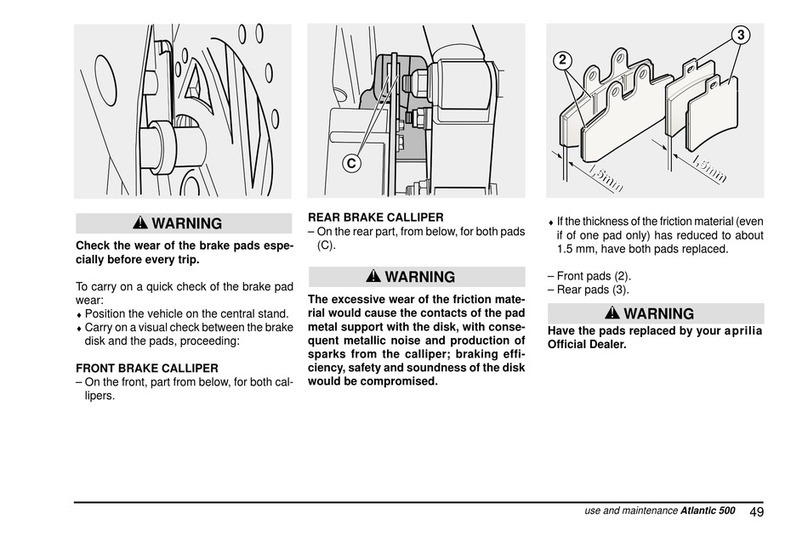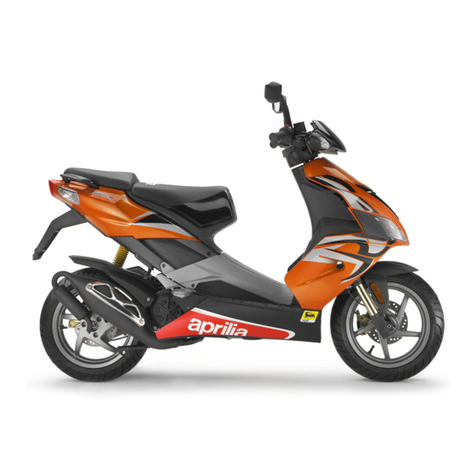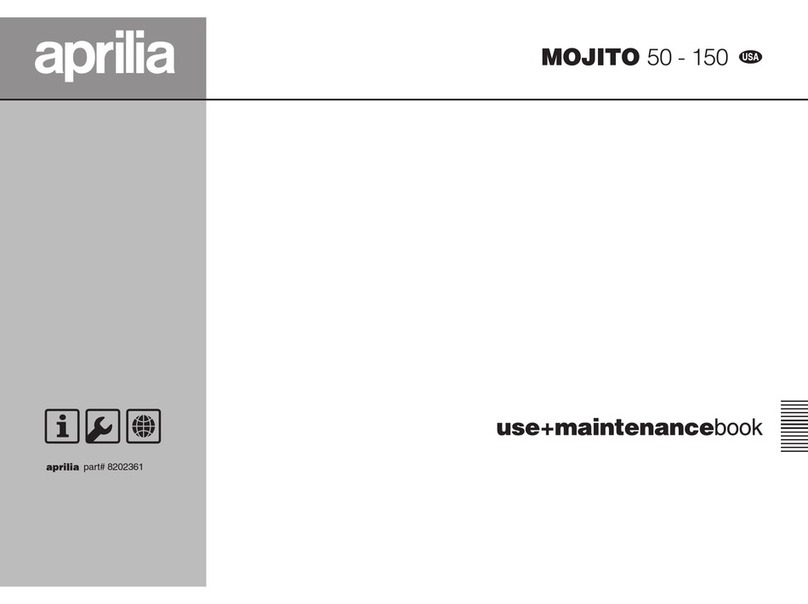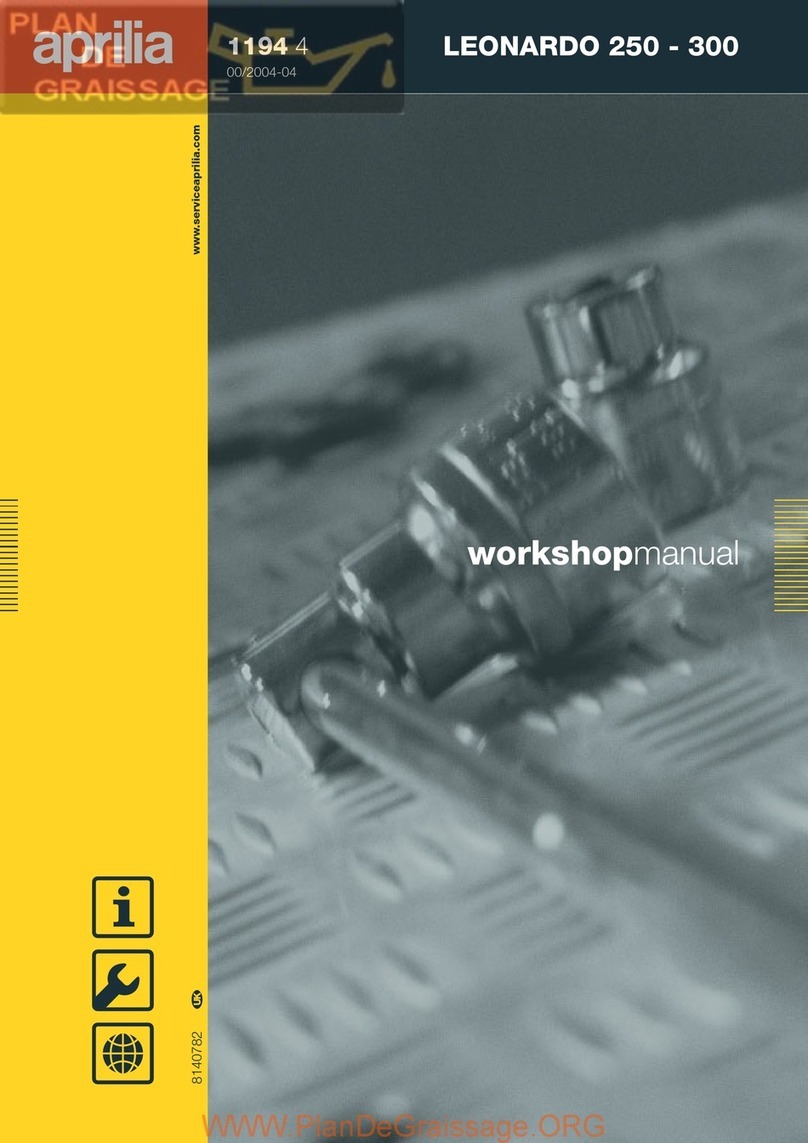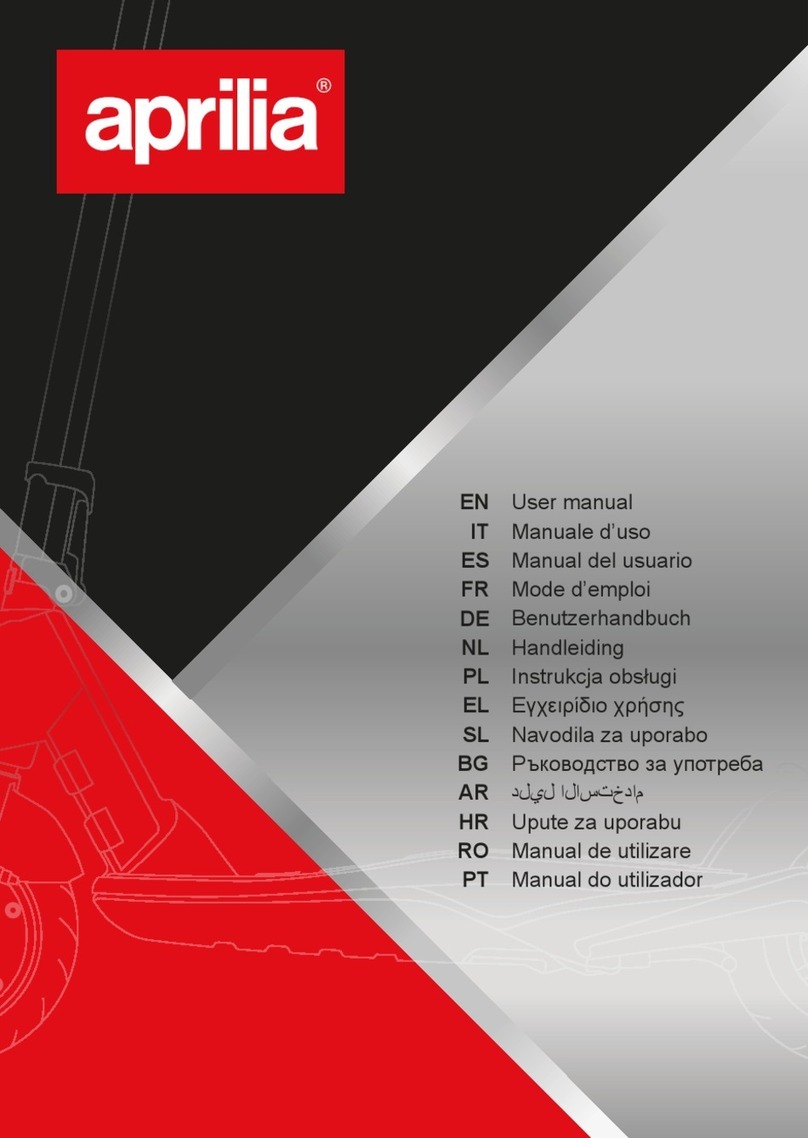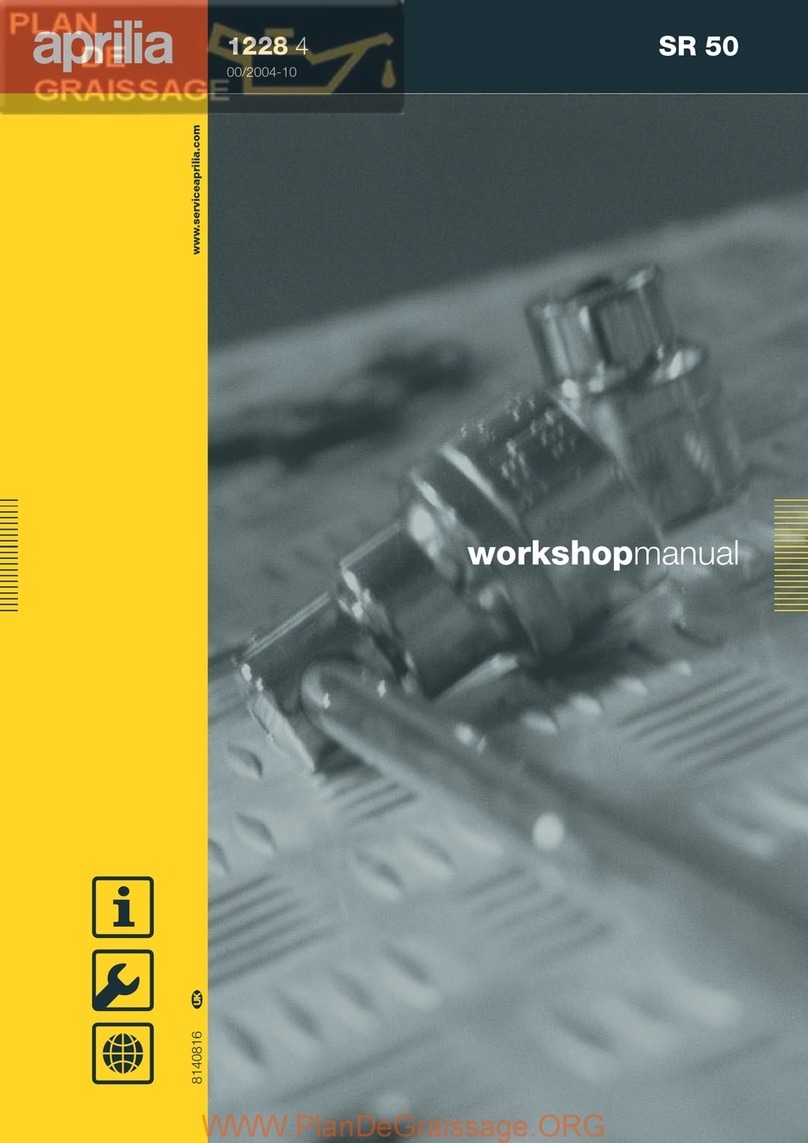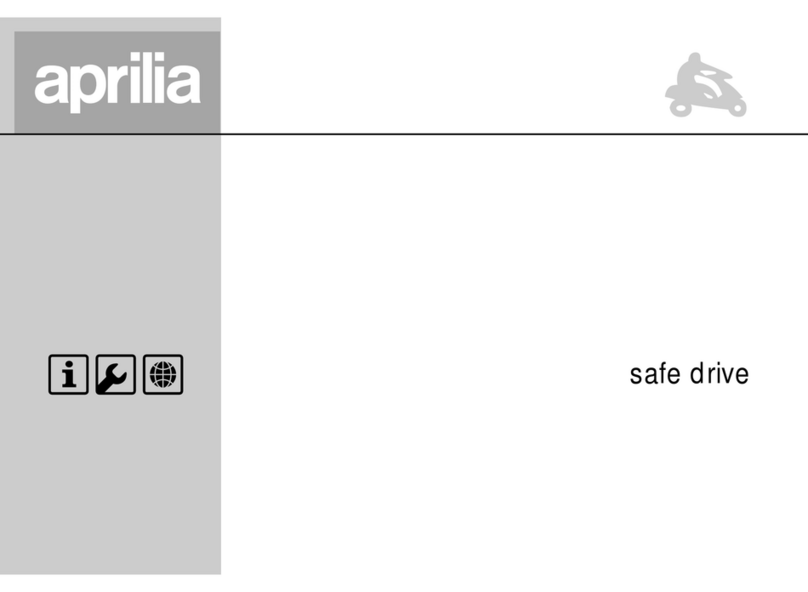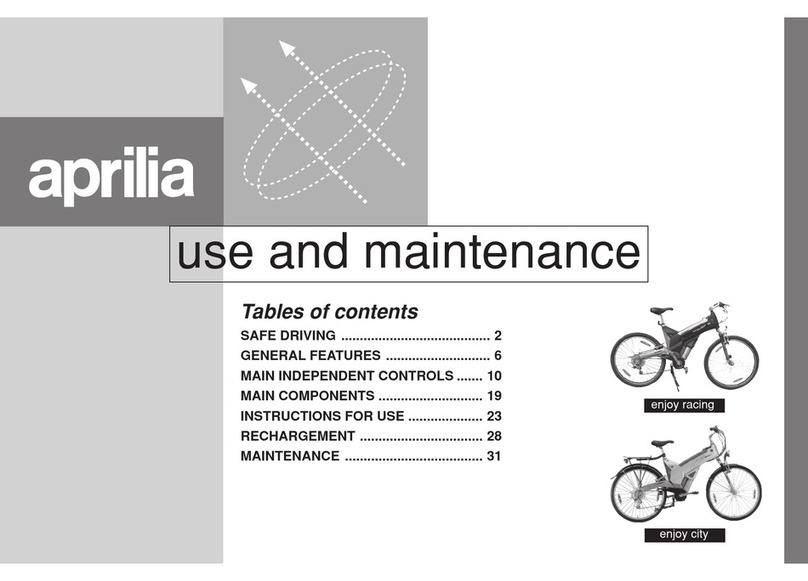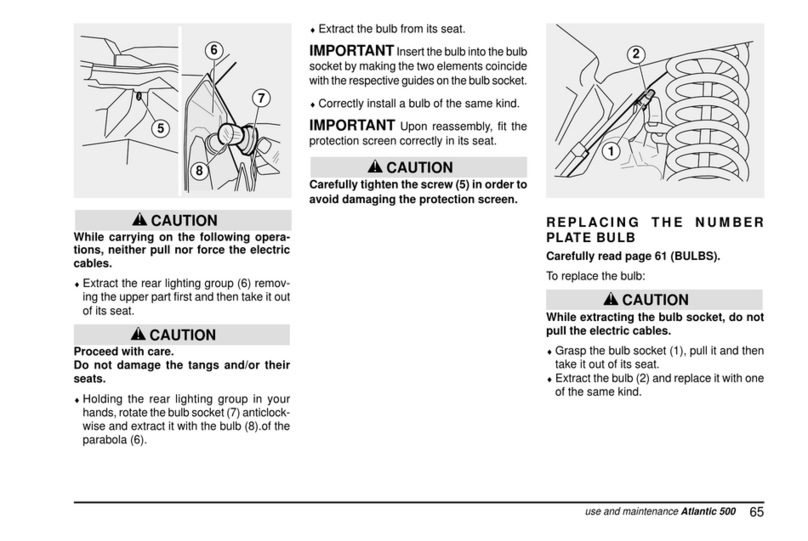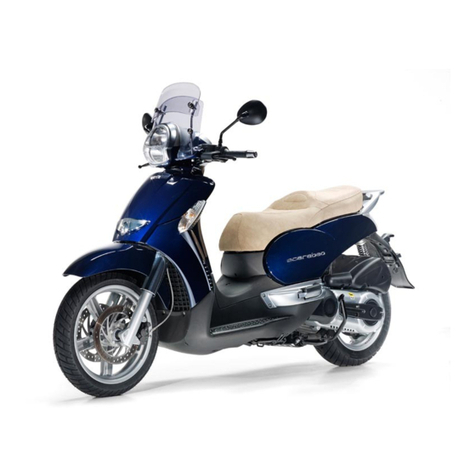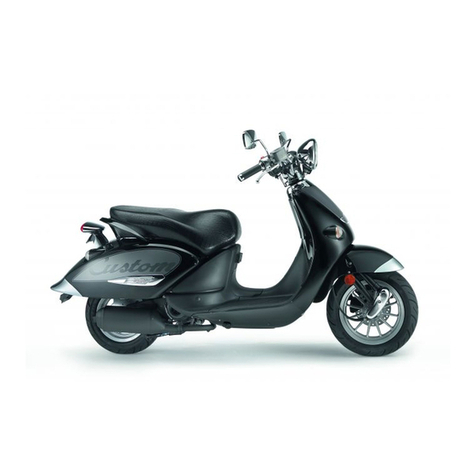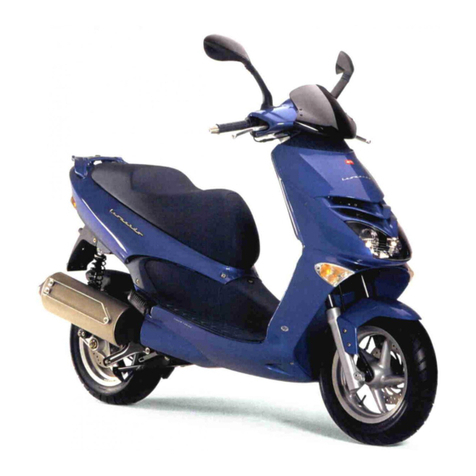
5
Area 51
!#%)4%-/4/2'!34!$/
aPELIGRO
Utilice guantes de látex para las operaciones de man-
tenimiento que implican el contacto con el aceite. El
aceite gastado del motor, si lo se deja repetidamente
en contacto con la piel durante largos periodos de
tiempos, puede producir el cáncer de la piel. Aunque
esto sea improbable, a menos que se maneje diaria-
mente aceite gastado , se aconseja que se lave las
manos con agua y jabón tras haberlo manejado.
MANTENGASE LEJOS DEL ALCANCE DE LOS NI-
ÑOS.
,)15)$/&2%./3
aATENCION
El líquido frenos puede dañar las piezas pintadas, de
plástico o goma. Durante las intervenciones en la ins-
talación de frenado, ponga un paño limpio de taller
sobre dichos componentes.
MANTENGASE LEJOS DEL ALCANCE DE LOS NI-
ÑOS.
,)15)$/2%&2)'%2!.4%
En algunas condiciones, el glicol etilénico contenido en el
líquido refrigerante del motor es inflamable y su llama es
invisible, pero es posible quemarse igualmente.
aPELIGRO
No vierta el líquido refrigerante del motor en la insta-
lación de escape o en los componentes del motor, ya
que éstos podrían estar suficientemente calientes
para producir el encendido del líquido refrigerante
que, al quemarse, emite una llama invisible.
El líquido refrigerante (glicol etilénico) puede causar
irritación de la piel y si es tragado es venenoso.
MANTENGASE LEJOS DEL ALCANCE DE LOS NI-
ÑOS.
No quite el tapón de llenado cuando el motor estáca-
liente. El líquido refrigerante estábajo presión y po-
dría ocasionar ustiones.
()$2/'%./9%,%#42/,)4/
$%,!"!4%2)!
aPELIGRO
La batería emite gases explosivos; mantenga cigarri-
llos, llamas y fuentes de chispas lejos de la batería
misma. Al activar o recargar la batería, asegúrese de
que la ventilación sea adecuada.
La batería contiene ácido sulfúrico (electrolito). El
contacto con la piel o con los ojos puede ocasionar
graves lesiones. Se recomienda que lleve vestidos de
protección y una máscara para la cara.
En caso de que el electrolito llegue a contacto con la
piel, enjuague de inmediato con mucha agua. Si el
electrolitollega a contacto con los ojos, enjuague con
mucha agua durante por lo menos 15 minutos y dirí-
jase inmediatamente a un médico.
El electrolito es venenoso.
De ingerirlo, beba una gran cantidad de agua o leche,
siga con leche de magnesia o aceite vegetal, luego di-
ríjase enseguida a un médico.
MANTENGASE LEJOS DEL ALCANCE DE LOS NI-
ÑOS.
02%#!5#)/.%3%).&/2-!#)/.%3
'%.%2!,%3
Durante la reparación, el desmontaje y el reensamblaje
del vehículo aténgase escrupulosamente a las recomen-
daciones siguientes.
aPELIGRO
Para cualquier tipo de operación se prohíbe el uso de
llama viva.
Antes de empezar cualquier intervención de manteni-
miento o inspección del vehículo, pare el motor y qui-
te la llave, espere a que el motor y lainstalación de es-
cape se hayan enfriado, luego levante, si posible, el
vehículo sobre un piso sólido y llano por medio del
equipo apropiado. Tenga particular cuidado con las
piezas aún calientes del motor y de la instalación de
escape, a fin de evitar ustiones.
El vehículo estáfabricado con piezas no comestibles;
no muerda, chupe, mastique ni trague ninguna parte
del mismo por ninguna razón.
De no resultar expresamente descrito, los grupos de-
ben ser instalados siguiendo el orden inverso de las
operaciones realizadas para el desmontaje. La even-
tual superposición de operaciones en las diferentes
remisiones a otros capítulos debe interpretarse con
lógica, evitando asíel inútil desmontaje de compo-
nentes. No utilice nunca el combustible como disol-
vente para la limpieza del vehículo.
Si se deben realizar soldaduras eléctricas, desconec-
te el cable negativo (-) de la batería. Cuando dos o
más personas trabajan simultáneamente, ponga aten-
ción en la seguridad de cada una de ellas.
ANTES DEL DESMONTAJE
–Elimine la suciedad,el barro, el polvo y los cuerpos ex-
traños del vehículo antes de desmontar los componen-
tes.
–Utilice, donde previsto, las herramientas especiales
proyectadas para este vehículo.
DESMONTAJE DE LOS COMPONENTES
–Marque las posiciones en todos los empalmes de co-
nexión (tubos, cables, etc.) antes de dividirlos e identi-
ficarlos con signos distintivos diferentes.
Cada pieza debe ser marcada claramente para poder-
la identificar en fase de instalación.
–Limpie y lave esmeradamente los componentes des-
montados, utilizando un detergente con un bajo grado
de inflamabilidad.
–Mantenga unidas las piezas acopladas entre ellas, ya
que se han “adaptado”la una a la otra a consecuencia
del desgaste normal. Unos componentes deben ser
utilizados juntos o sustituidos completamente.
–Manténgase lejos de las fuentes de calor.
